Combustion Performance of Various Polylactic Acid Plastics with Different Porous Structures Constructed by 3D Printing
Abstract
:1. Introduction
2. Experiments and Methods
2.1. Sample Preparation
2.1.1. Material
2.1.2. Sample Preparation
2.2. Experimental Method—Cone Calorimeter
- (1)
- The FGI is an index to assess the fire propagation; a lower FGI corresponds to lower fire spread or weaker heat transfer.
- (2)
- The FPI is a measure to assess the propensity of flashover; a higher FPI corresponds to a lower propensity of flashover, due to the reduced heat transfer.
3. Results
3.1. Combustion Performance
3.2. Smoke Production, Rate, and Temperature
3.3. Combustion Parameters
3.4. Discussion
3.4.1. Impact of Pore Shrinkage
3.4.2. Effect of Vortex Heat Dissipation
4. Conclusions
Author Contributions
Funding
Institutional Review Board Statement
Informed Consent Statement
Data Availability Statement
Conflicts of Interest
References
- Shi, S.; Dai, M.; Tao, X.; Wu, F.; Sun, J.; Chen, Y. 3D printed polylactic acid/graphene nanocomposites with tailored multifunctionality towards superior thermal management and high-efficient electromagnetic interference shielding. Chem. Eng. J. 2022, 450, 138248. [Google Scholar] [CrossRef]
- Baobaid, N.; Ali, M.I.; Khan, K.A.; Al-Rub, R.K.A. Fluid flow and heat transfer of porous TPMS architected heat sinks in free convection environment. Case Stud. Therm. Eng. 2022, 33, 101944. [Google Scholar] [CrossRef]
- Hu, X.S.; Gong, X.L. Experimental study on the thermal response of PCM-based heat sink using structured porous material fabricated by 3D printing. Case Stud. Therm. Eng. 2021, 24, 100844. [Google Scholar] [CrossRef]
- Geoffroy, L.; Samyn, F.; Jimenez, M.; Bourbigot, S. Innovative 3D printed design to conceive highly fire-retardant multi-material. Polym. Degrad. Stab. 2019, 169, 108992. [Google Scholar] [CrossRef]
- Li, X.; Wang, C.; Tian, C.; Fu, S.; Rong, Y.; Wang, L. Digital design and performance evaluation of porous metal-bonded grinding wheels based on minimal surface and 3D printing. Mater. Des. 2021, 203, 109556. [Google Scholar] [CrossRef]
- Pan, Z.Z.; Lv, W.; Yang, Q.H.; Nishihara, H. Aligned macroporous monoliths by ice-templating. Bull. Chem. Soc. Jpn. 2022, 95, 611–620. [Google Scholar] [CrossRef]
- Vazic, B.; Abali, B.E.; Yang, H.; Newell, P. Mechanical analysis of heterogeneous materials with higher-order parameters. Eng. Comput. 2021, 38, 5051–5067. [Google Scholar] [CrossRef]
- Malik, R.; Kim, Y.W.; Song, I.H. High interfacial thermal resistance induced low thermal conductivity in porous SiC-SiO2 composites with hierarchical porosity. J. Eur. Ceram. Soc. 2020, 40, 594–602. [Google Scholar] [CrossRef]
- Fleet, C.T.; Straatman, A.G. A model for the conduction shape factor in spherical void phase porous material. Int. J. Heat Mass Transf. 2021, 164, 120583. [Google Scholar] [CrossRef]
- Ji, G.; Fang, Y.; Zhou, J. Porous acoustic metamaterials in an inverted wedge shape. Extrem. Mech. Lett. 2020, 36, 100648. [Google Scholar] [CrossRef]
- Chen, J.; Jiang, L.; Wang, W.; Wang, P.; Li, X.; Ren, H.; Wang, Y. Facile construction of highly porous carbon materials derived from porous aromatic frameworks for greenhouse gas adsorption and separation. Microporous Mesoporous Mater. 2021, 326, 111385. [Google Scholar] [CrossRef]
- Shi, J.; Zhang, L.; Xiao, P.; Huang, Y.; Chen, P.; Wang, X.; Gu, J.; Zhang, J.; Chen, T. Biodegradable PLA nonwoven fabric with controllable wettability for efficient water purification and photocatalysis degradation. ACS Sustain. Chem. Eng. 2018, 6, 2445–2452. [Google Scholar] [CrossRef]
- Rydz, J.; Sikorska, W.; Kyulavska, M.; Christova, D. Polyester-based (bio)degradable polymers as environmentally friendly materials for sustainable development. Int. J. Mol. Sci. 2014, 16, 564–596. [Google Scholar] [CrossRef] [PubMed]
- Yin, Z.Y.; Wang, P.; Zhang, F. Effect of particle shape on the progressive failure of shield tunnel face in granular soils by coupled FDM-DEM method. Tunn. Undergr. Space Technol. 2020, 100, 103394. [Google Scholar] [CrossRef]
- Wang, Y.; Deng, J.; Zhao, J.; Shi, H. Benign design intumescent flame-retarding aliphatic waterborne polyester coatings modified by precipitated silica aerogel and aluminum powder. J. Mater. Res. Technol. 2021, 15, 6125–6135. [Google Scholar] [CrossRef]
- McCoy, C.G.; Stoliarov, S.I. Experimental characterization and modeling of boundary conditions and flame spread dynamics observed in the UL-94V test. Combust. Flame 2021, 225, 214–227. [Google Scholar] [CrossRef]
- Ghorashi, S.A.; Hashemi, S.M.; Hashemi, S.A.; Mollamahdi, M. Numerical study on the combustion characteristics in a porous-free flame burner for lean mixtures. Proc. Inst. Mech. Eng. Part C J. Mech. Eng. Sci. 2020, 234, 935–945. [Google Scholar] [CrossRef]
- Kim, J.H.; Jang, Y.S.; Kim, D.H. Multiple steady states in the oxidative steam reforming of methanol. Chem. Eng. J. 2018, 338, 725–763. [Google Scholar] [CrossRef]
- Lv, S.; Zhang, Y.; Tan, H. Thermal and thermo-oxidative degradation kinetics and characteristics of poly (lactic acid) and its composites. Waste Manag. 2019, 87, 335–344. [Google Scholar] [CrossRef]
- Duva, B.C.; Chance, L.E.; Toulson, E. Dilution effect of different combustion residuals on laminar burning velocities and burned gas Markstein lengths of premixed methane/air mixtures at elevated temperature. Fuel 2020, 267, 117153. [Google Scholar] [CrossRef]
- Catchpole-Smith, S.; Sélo RR, J.; Davis, A.W.; Ashcroft, I.A.; Tuck, C.J.; Clare, A. Thermal conductivity of TPMS lattice structures manufactured via laser powder bed fusion. Addit. Manuf. 2019, 30, 100846. [Google Scholar] [CrossRef]
- Gao, S.; Qu, S.; Ding, J.; Liu, H.; Song, X. Influence of cell size and its gradient on thermo-hydraulic characteristics of triply periodic minimal surface heat exchangers. Appl. Therm. Eng. 2023, 232, 121098. [Google Scholar] [CrossRef]
- Samson, S.; Tran, P.; Marzocca, P. Design and modelling of porous gyroid heatsinks: Influences of cell size, porosity and material variation. Appl. Therm. Eng. 2023, 235, 121296. [Google Scholar] [CrossRef]
- Azad, M.; Groulx, D.; Donaldson, A. Natural convection onset during melting of phase change materials: Part II—Effects of Fourier, Grashof, and Rayleigh numbers. Int. J. Therm. Sci. 2021, 170, 107062. [Google Scholar] [CrossRef]
- Tang, W.; Zhou, H.; Zeng, Y.; Yan, M.; Jiang, C.; Yang, P.; Li, Q.; Li, Z.; Fu, J.; Huang, Y.; et al. Analysis on the convective heat transfer process and performance evaluation of Triply Periodic Minimal Surface (TPMS) based on Diamond, Gyroid and Iwp. Int. J. Heat Mass Transf. 2023, 201, 123642. [Google Scholar] [CrossRef]
- Farthing, P.R.; Long, C.A.; Owen, J.M.; Pincombe, J.R. Rotating cavity with axial throughflow of cooling air: Flow structure. J. Turbomach. 1992, 114, 237–246. [Google Scholar] [CrossRef]
- Qureshi, Z.A.; Elnajjar, E.; Al-Ketan, O.; Al-Rub, R.A.; Al-Omari, S.B. Heat transfer performance of a finned metal foam-phase change material (FMF-PCM) system incorporating triply periodic minimal surfaces (TPMS). Int. J. Heat Mass Transf. 2021, 170, 121001. [Google Scholar] [CrossRef]
- Shih, Y.C.; Khodadadi, J.M.; Weng, K.H.; Ahmed, A. Periodic fluid flow and heat transfer in a square cavity due to an insulated or isothermal rotating cylinder. J. Heat Transf. Trans. Asme 2009, 131, 1314–1316. [Google Scholar] [CrossRef]
- Sun, X.; Meng, H. Large eddy simulations and analyses of hydrocarbon fuel heat transfer in vertical upward flows at supercritical pressures. Int. J. Heat Mass Transf. 2021, 170, 120988. [Google Scholar] [CrossRef]

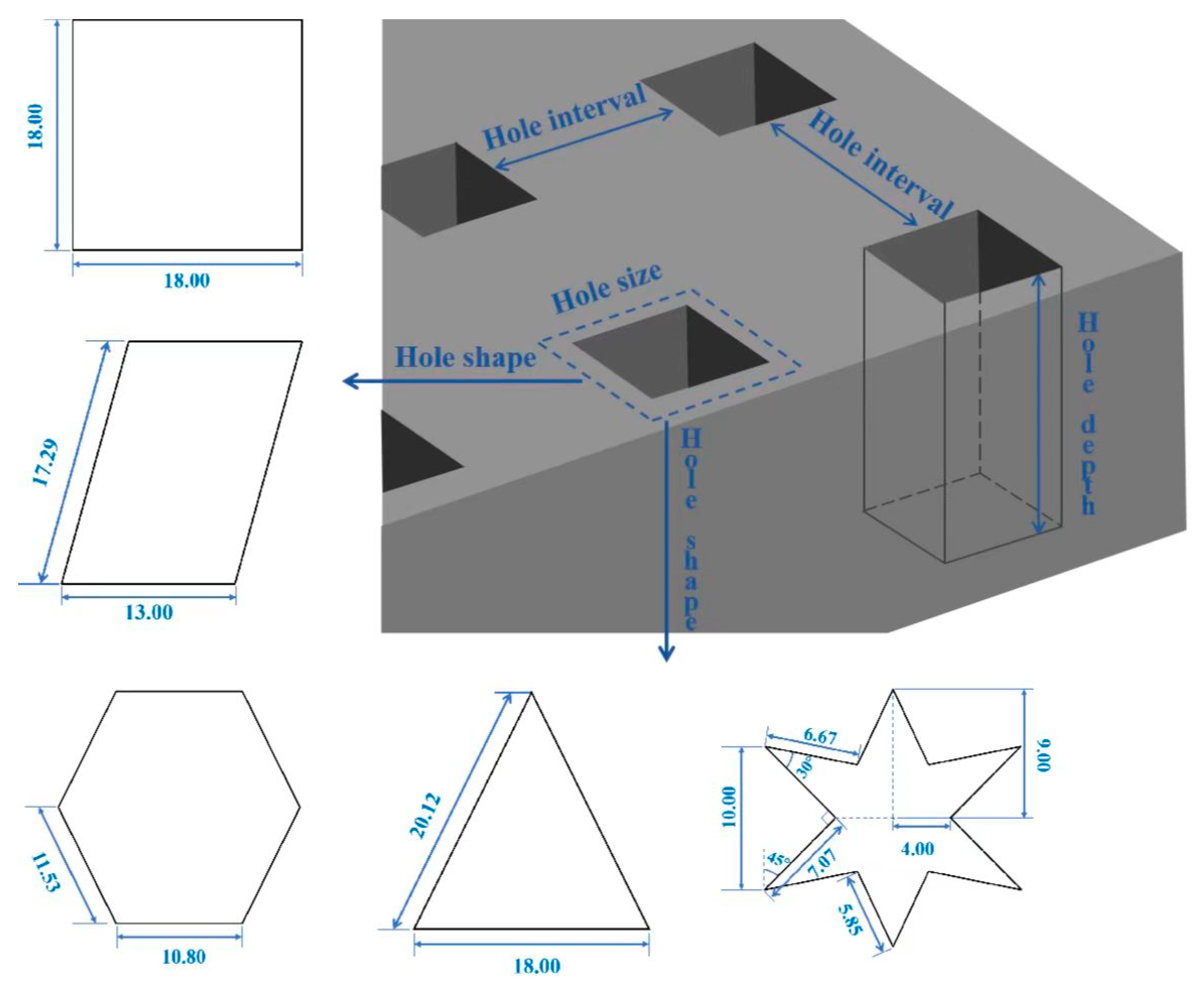
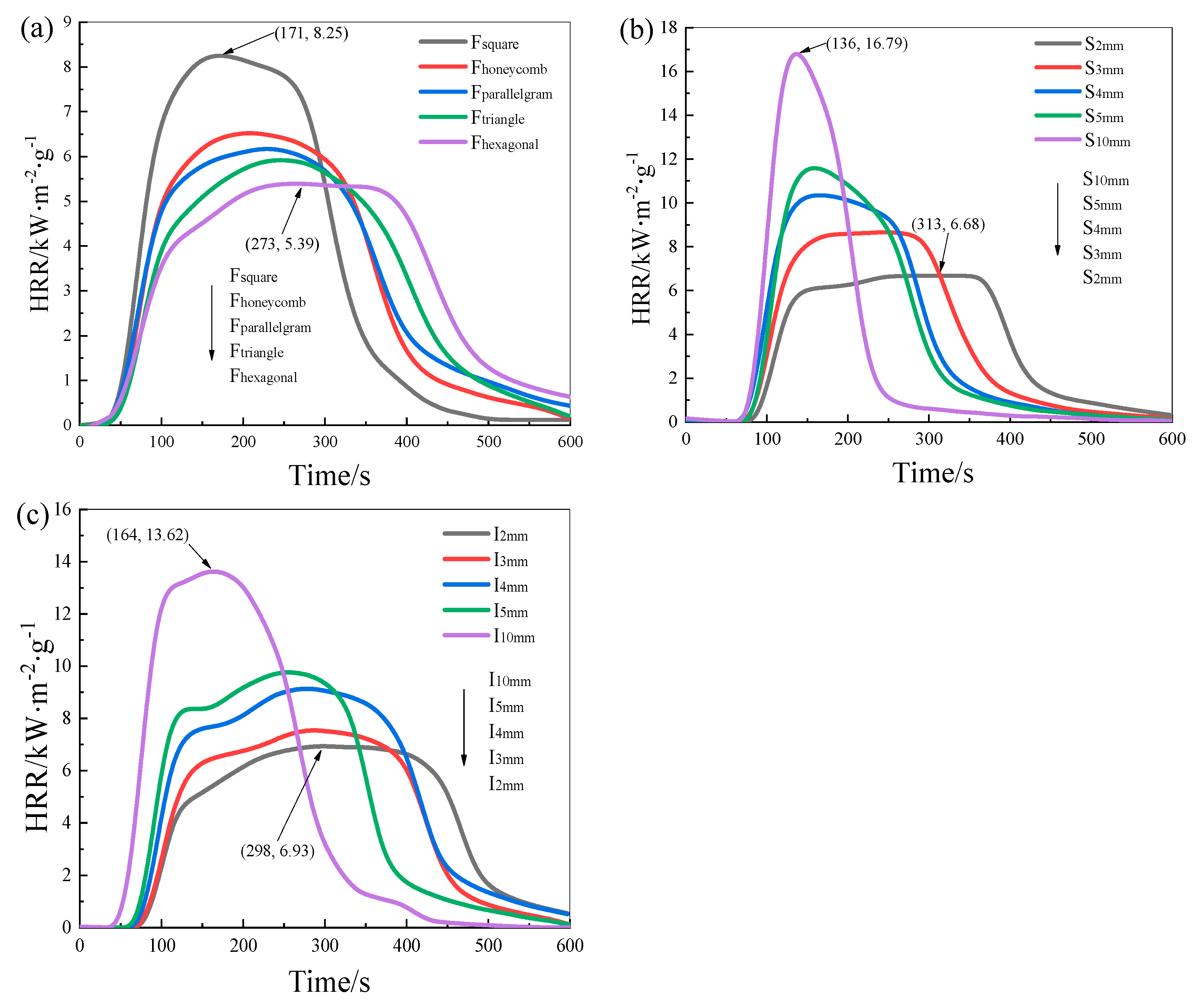
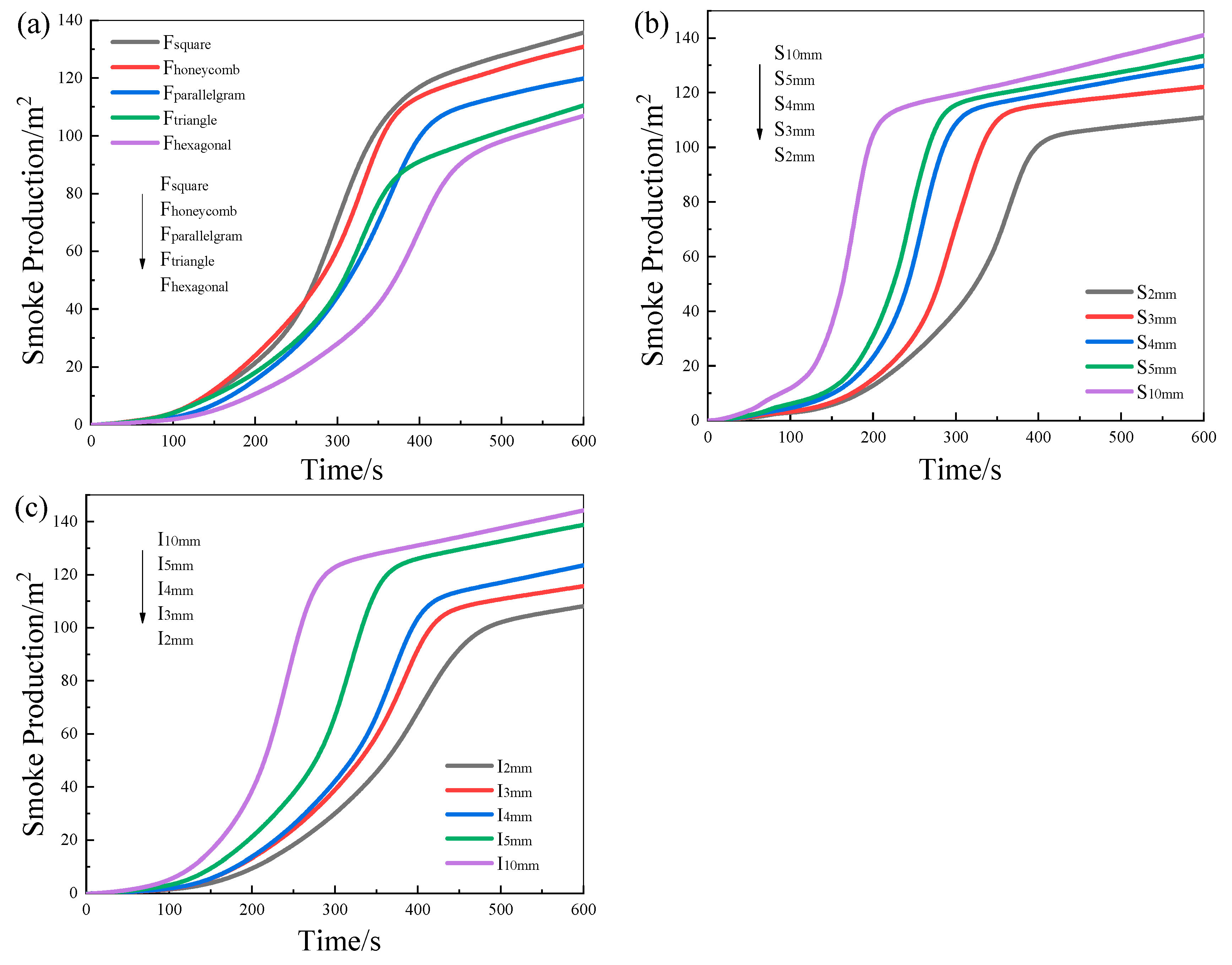

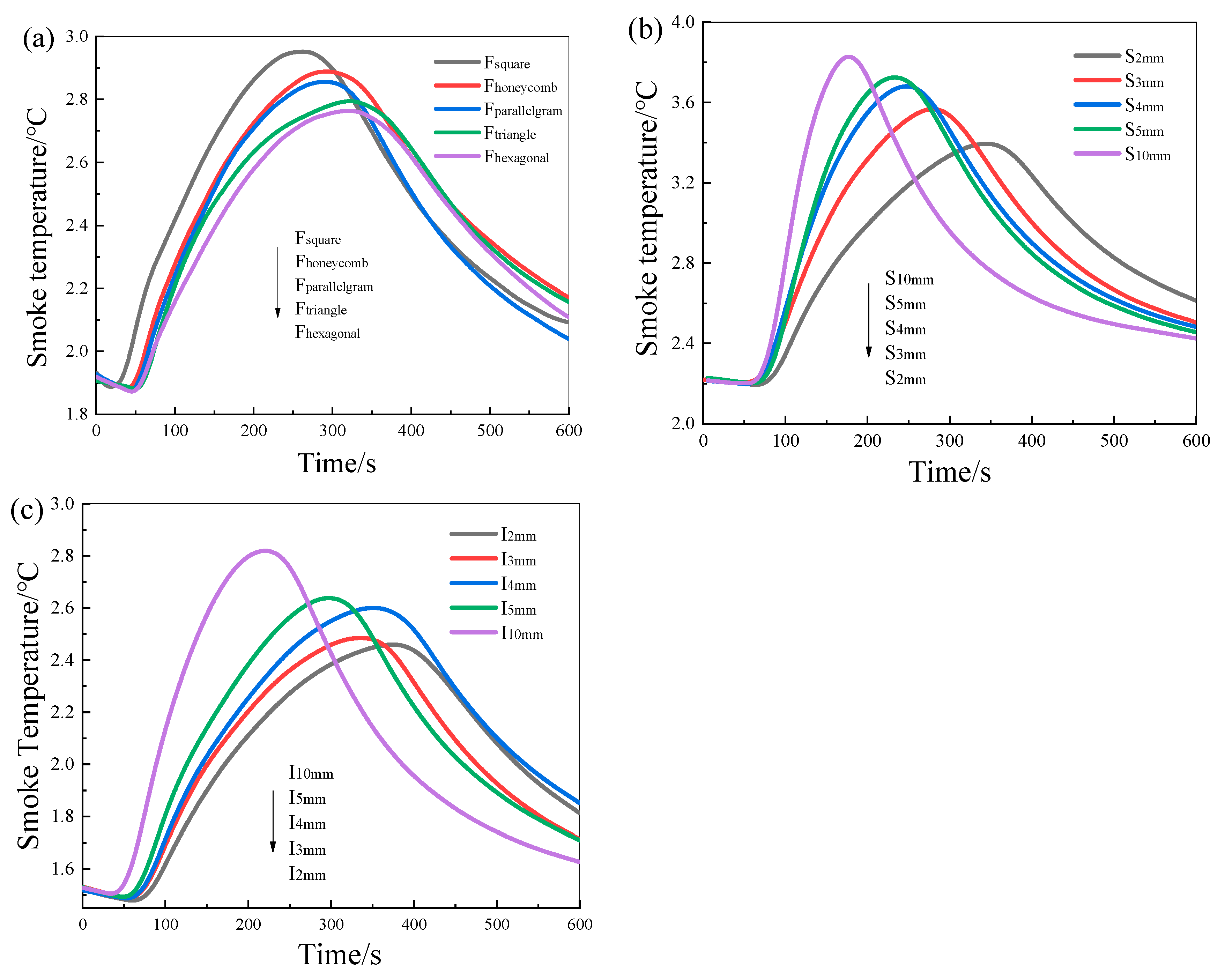
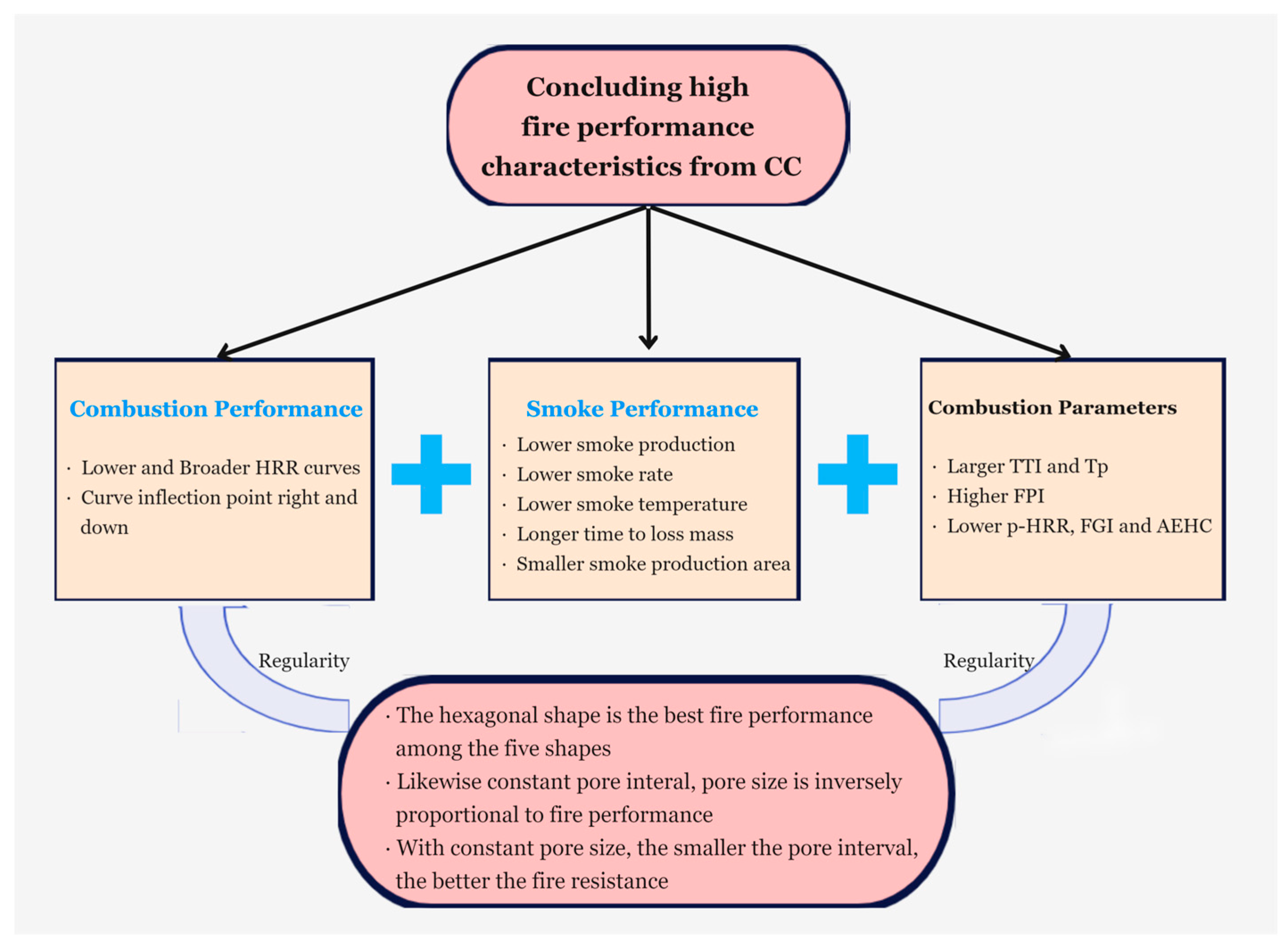
| Samples | Pore Shape | Hole Size/mm | Hole Interval/mm | Porosity/% | Printing Time/min | Sample Weight/g | |
|---|---|---|---|---|---|---|---|
| EXP. I | Fsquare | square | 18 | 2 | 65 | 202 | 33.75 |
| Fhoneycomb | honeycomb | 18 | 2 | 52 | 233 | 35.67 | |
| Fparallelogram | parallelogram | 18 | 2 | 47 | 242 | 36.19 | |
| Ftriangle | triangle | 18 | 2 | 33 | 249 | 38.25 | |
| Fhexagonal | hexagonal | 18 | 2 | 25 | 301 | 43.71 | |
| EXP. II | S2 mm | square | 2 | 1 | 33 | 414 | 36.11 |
| S3mm | square | 3 | 1 | 41 | 320 | 30.25 | |
| S4mm | square | 4 | 1 | 46 | 232 | 25.70 | |
| S5mm | square | 5 | 1 | 51 | 197 | 22.61 | |
| S10mm | square | 10 | 1 | 65 | 102 | 13.34 | |
| EXP. III | I2mm | square | 2 | 2 | 20 | 396 | 46.84 |
| I3mm | square | 2 | 3 | 13 | 372 | 42.29 | |
| I4mm | square | 2 | 4 | 10 | 348 | 39.68 | |
| I5mm | square | 2 | 5 | 6 | 322 | 35.13 | |
| I10mm | square | 2 | 10 | 3 | 173 | 24.40 | |
| Samples | Fsquare | Fhoneycomb | Fparallelogram | Ftriangle | Fhexagonal | S2 mm | S3 mm | S4 mm | S5 mm | S10 mm | I2 mm | I3 mm | I4 mm | I5 mm | I10 mm |
|---|---|---|---|---|---|---|---|---|---|---|---|---|---|---|---|
| T5% | 52 | 57 | 61 | 67 | 73 | 86 | 75 | 65 | 52 | 34 | 80 | 78 | 73 | 66 | 48 |
| T30% | 123 | 142 | 137 | 163 | 173 | 168 | 139 | 121 | 109 | 93 | 161 | 149 | 134 | 119 | 104 |
| T70% | 241 | 274 | 267 | 311 | 333 | 302 | 272 | 244 | 208 | 151 | 294 | 268 | 244 | 227 | 188 |
| T95% | 537 | 558 | 562 | 587 | 600 | 600 | 600 | 564 | 510 | 488 | 600 | 600 | 600 | 578 | 546 |
| Smoke production area/m2 | 72.18 | 63.57 | 59.74 | 53.85 | 42.24 | 32.41 | 39.43 | 45.38 | 47.83 | 56.40 | 41.18 | 53.57 | 59.74 | 63.85 | 72.24 |
| Samples | TTI/s | Tp/s | THR/MJ∙m−2∙g−1 | p-HRR/kW∙m−2 | FPI/s∙m2∙kW−1 | FGI/kW∙m−2∙s−1 |
|---|---|---|---|---|---|---|
| Fsquare | 32 | 171 | 2.02 | 8.25 | 3.88 | 0.05 |
| Fhoneycomb | 33 | 208 | 1.88 | 6.52 | 5.06 | 0.03 |
| Fparallelogram | 36 | 230 | 1.85 | 6.17 | 5.84 | 0.03 |
| Ftriangle | 39 | 246 | 1.79 | 5.96 | 6.64 | 0.02 |
| Fhexagonal | 43 | 273 | 1.64 | 5.39 | 7.98 | 0.02 |
| S2 mm | 63 | 307 | 1.82 | 6.68 | 9.43 | 0.02 |
| S3 mm | 58 | 247 | 2.07 | 8.66 | 6.70 | 0.04 |
| S4 mm | 51 | 166 | 2.08 | 10.35 | 4.93 | 0.06 |
| S5 mm | 44 | 159 | 2.13 | 11.58 | 3.80 | 0.07 |
| S10 mm | 31 | 136 | 2.24 | 16.79 | 1.85 | 0.12 |
| I2 mm | 61 | 298 | 2.24 | 6.93 | 8.81 | 0.02 |
| I3 mm | 57 | 260 | 2.35 | 7.53 | 7.57 | 0.03 |
| I4 mm | 50 | 278 | 2.43 | 9.13 | 5.48 | 0.03 |
| I5 mm | 45 | 255 | 2.59 | 9.77 | 4.61 | 0.04 |
| I10 mm | 39 | 164 | 2.88 | 13.62 | 3.36 | 0.07 |
Disclaimer/Publisher’s Note: The statements, opinions and data contained in all publications are solely those of the individual author(s) and contributor(s) and not of MDPI and/or the editor(s). MDPI and/or the editor(s) disclaim responsibility for any injury to people or property resulting from any ideas, methods, instructions or products referred to in the content. |
© 2023 by the authors. Licensee MDPI, Basel, Switzerland. This article is an open access article distributed under the terms and conditions of the Creative Commons Attribution (CC BY) license (https://creativecommons.org/licenses/by/4.0/).
Share and Cite
Yuan, C.; Wang, Y. Combustion Performance of Various Polylactic Acid Plastics with Different Porous Structures Constructed by 3D Printing. Fire 2023, 6, 425. https://doi.org/10.3390/fire6110425
Yuan C, Wang Y. Combustion Performance of Various Polylactic Acid Plastics with Different Porous Structures Constructed by 3D Printing. Fire. 2023; 6(11):425. https://doi.org/10.3390/fire6110425
Chicago/Turabian StyleYuan, Chao, and Yachao Wang. 2023. "Combustion Performance of Various Polylactic Acid Plastics with Different Porous Structures Constructed by 3D Printing" Fire 6, no. 11: 425. https://doi.org/10.3390/fire6110425





